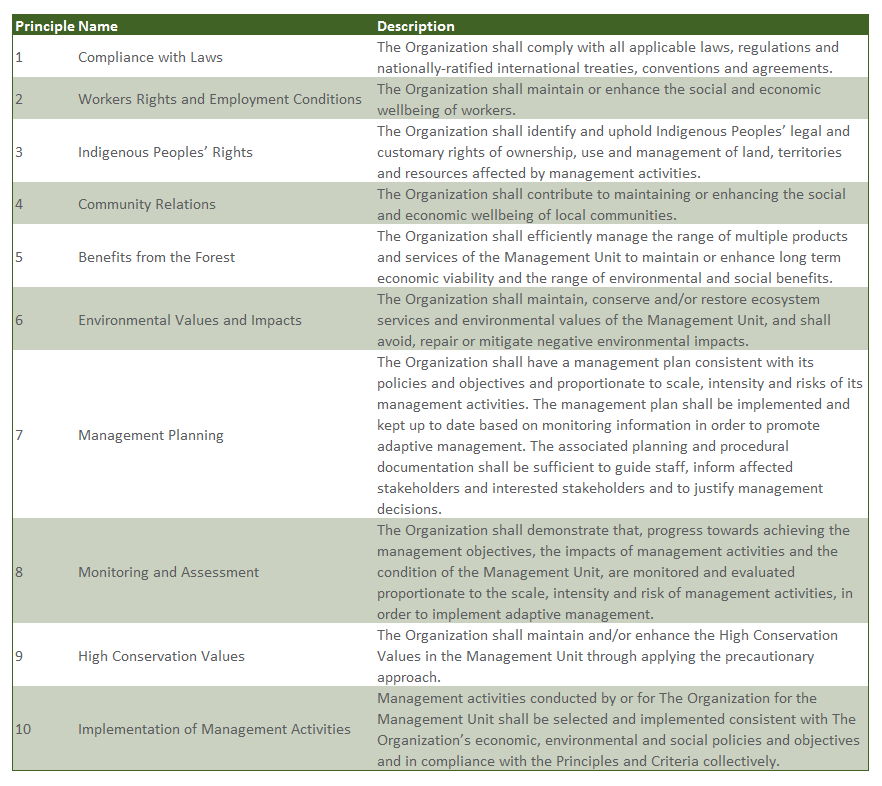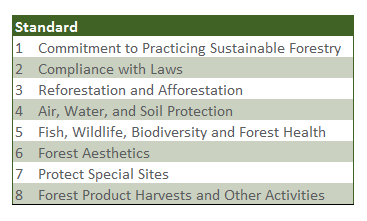3 min read
Demonstrating Sustainable Forest Management through Certifications
Hannah Jefferies : October 18, 2016

Forest certification systems emerged following the United Nations Conference on Environment and Development (UNCED or “Earth Summit”) held in Rio de Janeiro, Brazil in 1992 and, in particular, the Non-Legally Binding Authoritative Statement of Principles for a Global Consensus on the Management, Conservation and Sustainable Development of All Types of Forests[i] that recognized the importance of the conservation, management and sustainable development of forests. Since this summit, several certifications have begun to be used to certify timber and subsequent wood products as sustainable. Two important certifications are the Forest Stewardship Council (FSC) and the Programme for the Endorsement of Forest Certification (PEFC). These two certifications comply with the forest management requirements of the Sustainable Biomass Partnership (SBP) certification for biomass.
Forest Stewardship Council
The Forest Stewardship Council describes itself as a “global, not-for-profit organization dedicated to the promotion of responsible forest management worldwide.”[ii] FSC held its Founding Assembly and issued its first Forest Management and Chain of Custody certificates in 1993. In 1994, FSC A.C. was officially established as a legal entity in Mexico. FSC uses the following ten principles:
Table 1 FSC Principles[iii]
As of September 2016, approximately 34.0 million acres (13.8 million hectares) of forestland in the United States are FSC-certified.[iv]
Programme for the Endorsement of Forest Certification
Established in 1999 “in response to the specific requirements of small- and family forest owners,” the Programme for the Endorsement of Forest Certification is an international, non-profit organization.[v] PEFC is “dedicated to promoting sustainable forest management through independent third-party certification.” PEFC’s approach is to endorse national certification systems that meet the guidelines of its international Sustainability Benchmark. PEFC argues that this approach “allows standards to be adaptable to local conditions, consistent with national laws and regulations, and meet the expectations of stakeholders on the ground.” PEFC uses the following six criteria:
Table 2 PEFC Criteria

In the U.S., the Sustainable Forestry Initiative (SFI) and the American Tree Farm System (ATFS) comprise PEFC US. SFI Forest Management and ATFS standards are provided in Table 3 and Table 4 below.
Table 3 SFI 2015-2019 Forest Management Standard Objectives 
Table 4 American Tree Farm System 2015-2020 Standards
As of June 2016, over 64.4 million acres (25.6 million hectares) of American forestland are SFI certified, and 19.1 million acres (7.7 million hectares) are ATFS certified.[vi]
Sustainable Biomass Partnership Certification
The Sustainable Biomass Partnership has its roots in the Initiative of Wood Pellets Buyers (IWPB), which was formed by European utility companies[vii] and other parties[viii] in 2010. The goal of IWPB was to enable wood pellets to be traded in the event of a plant interruption by standardizing procurement contracts, technical specifications and sustainability requirements for wood pellets.[ix] IWPB transitioned to the Sustainable Biomass Partnership (SBP) in 2013.
Because the EU has no binding requirements for the sustainability of solid biomass, there are currently no harmonized standards for establishing the sustainability of biomass across the EU. SBP responded to this need by creating a certification framework based on the sustainability criteria of several EU member states that, if accepted more broadly, would provide a harmonized framework for documenting the sustainability of woody biomass thereby eliminating the need for biomass producers to undergo multiple audits and enabling biomass to be traded more easily among different countries.
In 2014, SBP published its Biomass Assurance Framework Consultation Draft, Response to Consultation and Biomass Assurance Framework Standards version 0.0; the SBP Framework version 1.0 launched in March 2015.[x] Standards covered by the framework are listed in Table 5.
Table 5 SBP Standards

Standard 1 “sets out the principles, criteria and indicators to be met by participating Biomass Producers (BPs) as part of a Supply base Evaluation (SBE).”[xi] It applies to woody feedstocks used by a Biomass Producer (BP) to manufacture, or dry, biomass. Feedstock certified under SBP-approved Forest Management Schemes does not have to be evaluated against Standard 1. FSC and PEFC-endorsed Forest Management Schemes are SBP-approved Forest Management Schemes.
For feedstock not certified under FSC or PEFC, SBP’s Standard 1 takes a regional approach[xii] to verification through the use of Supply Base Evaluations (SBEs). Each SBE includes both a Risk Assessment (RA) and a Supplier Verification Programme (SVP). The standard allows SBP to endorse a Regional Risk Assessment (RRA) that has been completed in compliance with SBP requirements. An endorsed RRA can replace the RA requirement of the SBE for the region covered by the RRA.
Feedstock is evaluated against the following criteria to demonstrate legality (Table 6) and sustainability (Table 7). The standard’s definitions of “legal” and “sustainable” are adapted from the UK’s Timber Procurement Policy and supplemented with the Netherlands’ sustainability requirements for solid biomass. Each of these criteria has associated indicator(s) (not shown).
Table 6 SBP Standard 1 – Legal Source Criteria

Table 7 SBP Standard 1 – Sustainable Source Criteria 
[i] http://www.un.org/documents/ga/conf151/aconf15126-3annex3.htm. Retrieved 09/01/2016.
[ii] https://ic.fsc.org/en/about-fsc. Retrieved 09/01/2016.
[iii] https://us.fsc.org/en-us/what-we-do/mission-and-vision. Retrieved 09/01/2016.
[iv] https://ic.fsc.org/preview.facts-figures-september-2016.a-6205.pdf. Retrieved 09/21/2016.
[v] http://pefc.org/standards-revision/about-pefc. Retrieved 09/01/2016.
[vi] http://www.pefc.org/images/documents/PEFC_Global_Certificates_-_June_2016.pdf. Retrieved 09/01/2016.
[vii] GDF SUEZ, RWE, E.On, Vattenfall, Drax Plc, Dong.
[viii] Certifying companies Inspectorate and Control Union; technical expert Laborlec.
[ix] http://www.laborelec.be/ENG/wp-content/uploads/2012/08/2012-06-05-IWPB-Initiative_Wood_Pellets_Buyers-Sustainability_principles_Report1_Public_draft-v2.pdf. Retrieved 09/02/2016.
[x] http://www.sustainablebiomasspartnership.org/about-us/timeline. Retrieved 09/02/2016.
[xi] http://www.sustainablebiomasspartnership.org/docs/2015-03/sbp-standard-1-feedstock-compliance-standard-v1-0.pdf. Retrieved 08/30/2016.
[xii] This approach is grounded in the risk-based regional approach to bespoke evidence specified by the Timber Standard for Heat and Electricity 2014 from the UK’s Department of Energy and Climate Change (DECC).





